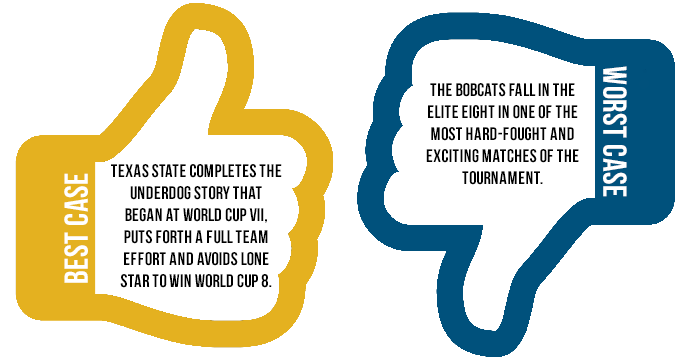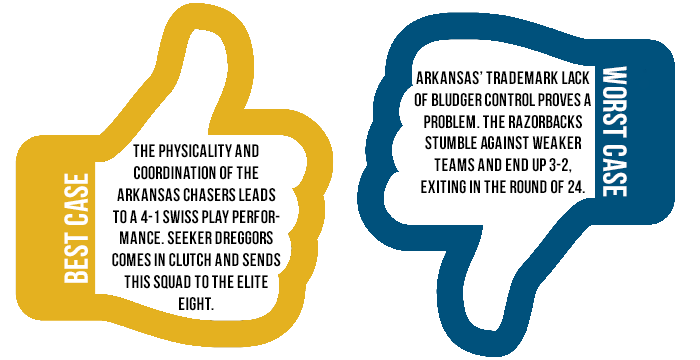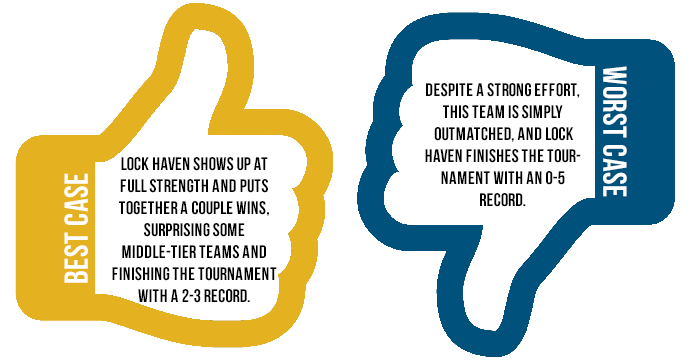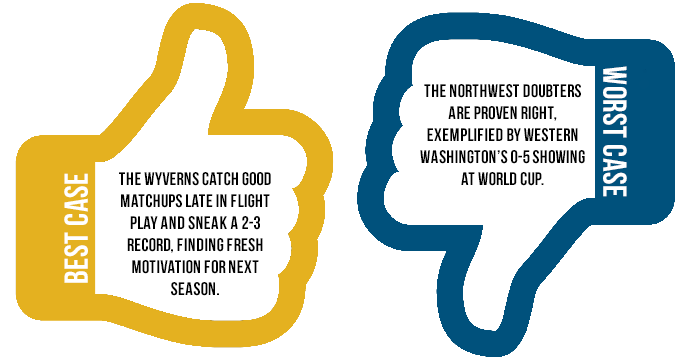- Rule, Britannia, no more?
- Unpopular Opinions: US Quadball Cup 2023
- Proven Contenders: University of Virginia
- Proven Contenders: Rutgers University
- Proven Contenders: University of Michigan
- Proven Contenders: Creighton University
- Different Perspectives: A Look Inside USA Ultimate
- Antwerp QC, Much of Belgian Core, Leaves Competitive Quidditch
Part XXIII
- Updated: April 1, 2015
Rock Hill Roll Call is your in-depth guide to the 80 teams that will compete for the title of World Cup 8 Champion. We’ve reached out to writers and analysts all over the country to bring you the lineups, strategies, focal points and aspirations of each and every attending team. Whether you are looking for a leg up on the competition or just want a detailed preview of the sport’s main event, this is the place for you.
By Dan Hanson
It is unbelievable that a recently successful Texas State University program has such a key player who somehow does not come up much in conversation as one of the league’s most valuable players. This player is Ryan Peavler.
To be fair, Texas State’s remarkable performance since bracket play of World Cup VII can be mostly attributed to its depth and chemistry across its entire roster. But none of it would be possible without Peavler in the middle of everything.
Peavler is not exactly physically intimidating. He is small and skinny, which would suggest that he could play the speed and smarts style of other top beaters such as Chris Seto. The former soccer star plays with those elements and adds a dynamic of fierce strength on top of them. Peavler is your classic pound-for-pound stud, and he uses his speed and smarts to hit with the strength of a much larger beater. But the true key for Peavler’s game is that he uses his intelligence, experience and speed to always be in the optimal position. This forces opponents out of their comfort zone and establishes control of the pace for his team.
The team around him has developed a play style perfectly suited for that approach. Eric Reyes, Tyrell Williams and Rich Kemp are not hero-ballers or superstars on their own, but together make an unstoppable two-way squad. Beth Clementi makes for a great complement to Peavler’s abilities, and Jackson Johnson plays major minutes substituting for Peavler without any significant drop off–even with a very different style.
It is hard to imagine that this Texas State team lost to Macaulay Honors College and trailed the Utah Crimson Fliers by 40 on the Saturday of World Cup VII. It was a team that was always on the outside looking in, but once all the pieces fell into place, the squad never looked back and now can call itself one of the most significant contenders at World Cup 8.
Solid Southwest tier-two teams such as Texas A&M University, Loyola University, Texas Tech University and UTSA have all failed to keep Texas State in snitch range by the end of their games. While many thought Texas State’s run to the finals last year was a fluke caused by an easy bracket, this team has spent all season proving that wrong and will settle for nothing less than a championship.
 By Anonymous
By Anonymous
Texas State is one of the smartest teams in the league. The Bobcats adapt their play to suit their opponent without sacrificing offensive or defensive efficiency. To beat this squad, a team will need hyper-aggressive beaters to tame the beast that is Johnson and to keep Clementi and Peavler at bay.
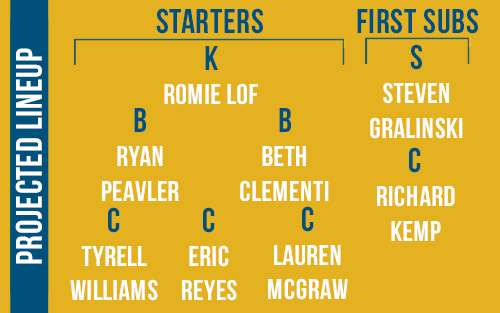 Johnson is deadly with a bludger, while Peavler is always a physical presence on offense and is simultaneously a defensive powerhouse. The Bobcats excel in fast-breaks and no-bludger plays with players such as Williams, Kemp and Reyes, who can all take the ball to the hoops against no bludgers. Throw in the fact they they have a crisp passing game paired with smart cuts and great spacing, and you have a team that is a dangerous threat to ending the University of Texas’s World Cup streak.
Johnson is deadly with a bludger, while Peavler is always a physical presence on offense and is simultaneously a defensive powerhouse. The Bobcats excel in fast-breaks and no-bludger plays with players such as Williams, Kemp and Reyes, who can all take the ball to the hoops against no bludgers. Throw in the fact they they have a crisp passing game paired with smart cuts and great spacing, and you have a team that is a dangerous threat to ending the University of Texas’s World Cup streak.
Watch for off-ball chasers Hunter Daigle, Lauren McGarrah and Justin Lopez, as they get buckets behind the hoops every game. Texas State is going far at World Cup, and the Bobcats have a seeker combination that is as deadly as any. Steven Gralinski and Austin Lafoy are a contrasting seeker pair. Gralinski is shorter and more aggressive and Lafoy is lanky and fast. With good beater help, Lafoy and Gralinski could carry this team to a World Cup championship.
By We Breathe Quidditch
At first glance, the University of Arkansas’ beaters are not impressive in the least. In every single game at Southwest Regionals, the Razorbacks struggled to obtain bludger control. They held bludger control for 15 percent of the game against UTSA and displayed similar performances against Clone Star Quidditch Club and Austin Quidditch. The reason for this, however, is plain strategy.
Arkansas hardly ever brings up a bludger on offense when going up against control. While some might deem this silly, the strategy ensures that Arkansas is at least partially protected against any fast break. Arkansas beaters are also very fast and capable of outrunning opposing beaters for loose bludgers. The result? Almost no drives occur against a zero-bludger Arkansas defense during the seeker floor. Furthermore, the physicality of Arkansas’ chasers ensures that the Razorbacks can drive and score almost every time if both teams’ beaters are drawn into beater play.
Put in context, it is both understandable and extremely impressive that the Arkansas offense and defense are able to function despite never winning the bludger control battle.
The reason for this is the superb coordination of the Arkansas chasers. The Razorbacks’ chaser lineup is one of the most coordinated in the nation, rivaling even those of University of Texas, Texas State University and Baylor University. This impressive coordination can especially be seen in the UTSA game. Whenever a pass flew to a chaser who was about to be beat, another Arkansas chaser ran in to pick up the ball after it was dropped. When a pass was shot above a chaser in front of the hoops, the chaser behind the hoops instantly reacted and ran to where ever the quaffle rolled and picked it up and scored.
So how does one go about beating a team with such impressive coordination? The key is beater strategy. Even when Arkansas had one bludger on defense, UTSA was able to make key plays during fast breaks. Therefore, the way to beat Arkansas rests on physicality and eliminating the lone beater on defense. Texas, in fact, was able to win against Arkansas despite its numerous injuries solely due to outmuscling the Razorbacks and its perfect use of the 1.5 bludger strategy.
While Arkansas does have the benefit of extremely physical and coordinated chasers, aggressive yet conservative bludger play can neutralize any advantage the Razorbacks gain from their strategy.
 By Anonymous
By Anonymous
The strength of Arkansas lies in its strategy. The Razorbacks do not run one set defense, but alternate between a zone defense and a tight man defense many times during the same game. When they do not have bludger control, they rarely if ever bring a bludger up on offense, choosing instead to have a lone beater back to guard against the fast-break threat. Arkansas is an extremely physical team, and driving past the point requires speed or a series of picks and handoffs.
On offense, during the few times Arkansas has bludger control, the Razorbacks use the 1.5 bludger strategy religiously. Both beaters James Musick and Caleb Deaver are effective at the offensive 1.5 and can consistently take out the lone defensive beater and open a clear driving lane for the myriad of powerful drivers on the team.
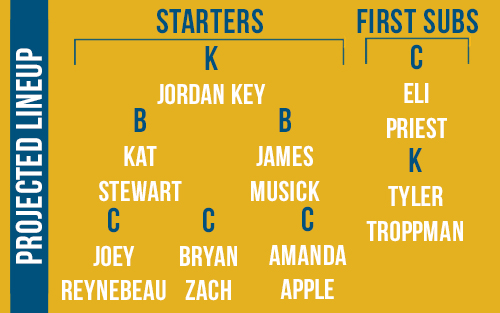 The weakness of Arkansas lies in its lack of bludger control. If a team can regularly retrieve bludger control against the Razorbacks, it is likely to retain it for a large period of time. At the same time, beaters defending against the Razorbacks should be very coordinated and not afraid to make their presence felt on the pitch. Sufficient beater presence by the hoops and at the point throws off Arkansas’ style of play. Clone Star beater Eric Bilanoski used this pressure at point to lead his team to an upset of Arkansas. Offensively, a fast, elusive driver is the best chance of driving past point. UTSA keeper Austin Villejo was frequently able to get past the point and score in this manner.
The weakness of Arkansas lies in its lack of bludger control. If a team can regularly retrieve bludger control against the Razorbacks, it is likely to retain it for a large period of time. At the same time, beaters defending against the Razorbacks should be very coordinated and not afraid to make their presence felt on the pitch. Sufficient beater presence by the hoops and at the point throws off Arkansas’ style of play. Clone Star beater Eric Bilanoski used this pressure at point to lead his team to an upset of Arkansas. Offensively, a fast, elusive driver is the best chance of driving past point. UTSA keeper Austin Villejo was frequently able to get past the point and score in this manner.
Arkansas’ strategy can also hurt this team if its opponents have capable drivers. While Arkansas enjoys success employing the offensive 1.5 beater strategy, the Razorbacks are mediocre at best at defending against it. If a team’s chasers can outmuscle the Arkansas chasers, a physical 1.5 beater strategy on offense can result in consistent goals.
If a team’s beaters can maintain control against Arkansas, they might be able to also neutralize Arkansas’ biggest threat: seeker Eric Dreggors. Dreggors is a relentless seeker and has made many SWIM grabs by virtue of having great agility and a great dive. If Dreggors can be slowed by effective snitch-on-pitch beating, Arkansas becomes a very vulnerable team
 By Greg Astolfi
By Greg Astolfi
Lock Haven University will be an interesting addition to the World Cup tournament field. This Mid-Atlantic team recently received a deferred World Cup bid after failing to qualify at its regional tournament in November. The team’s official record so far this season leaves a lot to be desired. Lock Haven is currently well below .500 with its only wins coming against non-qualifiers such as the Hopkins Hallows and Grove City College. However, when this team is at full strength, it can keep some games close against mid-level competition. Lock Haven’s success in Rock Hill will hinge upon the team’s ability to bring a full roster.
Throughout the regular season, Lock Haven has had inconsistent showings with its roster depth. This includes this past weekend at Founders’ Cup where the team only brought 11 players. This tournament featured nearly all of the the Mid Atlantic’s top and middle-tier teams. What would have been a good chance to gain valuable play time against other qualifiers quickly went downhill, as Lock Haven lost all of its pool play games out of range. In contrast, at the Mid-Atlantic Regional Championship, Lock Haven boasted a full–and strong–roster. Despite not qualifying, the squad played a lot of close competitive games that weekend, proving that when it is at full strength, it can put out a good performance.
In a tournament where having depth is a key component for success, Lock Haven will have to show up at full strength if it wants to come away with wins. This could prove problematic for the team, as it now only has two weeks to make travel arrangements to Rock Hill. However, if Lock Haven can manage to bring its full roster, it could see some success.
 By Anonymous
By Anonymous
Lock Haven is a late addition to the World Cup field. Despite not qualifying in the Mid-Atlantic Regional Championship, this team does have a lot of skill and athleticism on its roster. Its main flaw, however, seems to be a lack of clear strategy. While athletic, this team is still improving schematically. Lock Haven is not a team that will blow you away with a ton of star-power, but it makes up for that with an insatiable work ethic. Led by the team’s founder, Jonyull Kosinski, this team always plays with a lot of hype and intensity. Kosinski is a speedy chaser who is dangerous when he can get out in transition, and his experience and leadership have been an integral part of his team’s development. The rest of Lock Haven’s chaser corps is athletic, and while they are not as physical as many top teams, they can run and keep up with top-notch opponents.
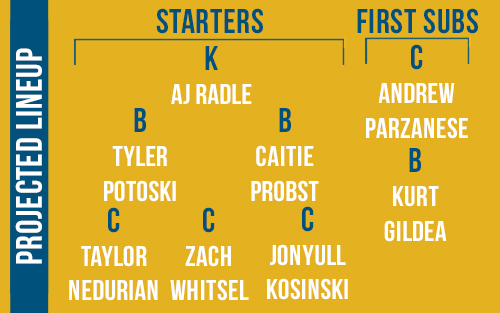 The most dangerous part of Lock Haven’s lineup is its starting beating duo of Caitie Probst and Tyler Potoski. These two are a key part of both the team’s defense and offense. Potoski possesses an absolute cannon for an arm, and as result he can cover long distances with his throws. This allows him to make key beats even when he gets caught out of position. Furthermore, Potoski can wreak havoc on offense leaving big holes for the chasers to drive through. Probst is the perfect complement to Potoski’s more aggressive style of beating. She is great at keeping possession and is very smart about knowing when to use her bludger.
The most dangerous part of Lock Haven’s lineup is its starting beating duo of Caitie Probst and Tyler Potoski. These two are a key part of both the team’s defense and offense. Potoski possesses an absolute cannon for an arm, and as result he can cover long distances with his throws. This allows him to make key beats even when he gets caught out of position. Furthermore, Potoski can wreak havoc on offense leaving big holes for the chasers to drive through. Probst is the perfect complement to Potoski’s more aggressive style of beating. She is great at keeping possession and is very smart about knowing when to use her bludger.
The main problem facing this Lock Haven beater corps is depth. Potoski is by far the team’s best male beater, and he often plays nearly the entirety of every game. However, when he is forced out of the game due to fatigue, there is a noticeable difference in this team’s chemistry and cohesion. Oftentimes the game opens up and opposing teams can pick out driving lanes with more ease.
All in all, Lock Haven has the ability to hang with middle-tier opponents. Its roster is athletic enough to keep up; however, the team still needs to work on its strategy. The out-of-region experience Lock Haven will gain at World Cup should only help it to improve. If this squad shows up at full strength come April, it could end up surprising a few teams.
 By George Williams
By George Williams
If there is a team that is the embodiment of the Northwest region, it is the Western Washington University Wyverns. The Wyverns are known for being an incredibly friendly yet competitive team with a heavy strategic focus on their chaser play. While their chasing line should be able to stack up well against most teams in Rock Hill, their beating style is underdeveloped and will be expected to struggle.
The Wyverns were able to easily dominate teams with less beating experience at the Northwest Regional Championship with keeper and physical specimen Ross Schram von Haupt taking over games and scoring the majority of their goals. They avoided snitch-range games the entire weekend with fast drives and dunks before falling to the Boise State University Abraxans in the championship match. Although Boise State’s chaser line also excelled against the Wyverns, the Abraxans’ success can also be attributed to superior beater play.
The Wyverns do have competent solo beaters in Matt Nagel and captain Nicole Jackson. Combined with formidable defensive chasing, these beaters are able to lock down the team’s defense when they have bludger control. However, in matches against more experienced beaters such as Boise State, the Wyverns’ beaters were unable to regain control, resulting in their chasers struggling offensively and defensively.
Unfortunately for the Wyverns, most teams at World Cup 8 will have stronger beating games than teams like the Abraxans–Western Washington’s best competition in the Northwest. If this team is unable to make adjustments and create ways to regain bludger control, the Wyverns will struggle against mid-level opponents. With World Cup less than two weeks away, the Wyverns have their work cut out for them if they want to make a strong statement about the strength of the Northwest.
 By Dan Hanson
By Dan Hanson
Western Washington enters World Cup 8 with one quality that it will either embrace to fuel the team or allow to bring itself down: it is the single least experienced squad in Rock Hill.
The Wyverns boast an 11-3 record, good for No. 29 by USQ’s standings as of press time. However, break this down and it leaves just a 2-1 record against the two other World Cup-qualified teams in the fall and a 0-2 record against them in the spring. Granted, the 120*-10 official loss to the University of British Columbia in March can be taken with a grain of salt due to an 8-person roster missing several key players, but the fact remains: The other two Northwest teams that qualified World Cup are on a faster trajectory of improvement than Western Washington.
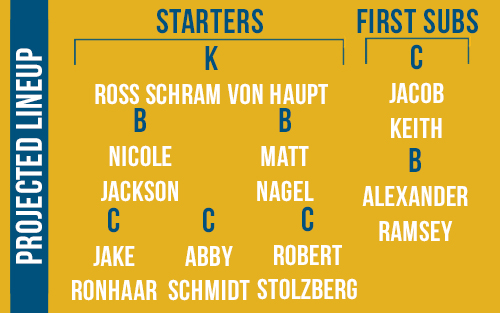 Although Boise State decided to drop its World Cup bid, the Abraxans have faced the LA Gambits, the Utah Crimson Elite and Northern Arizona University this year, and have allowed key players to gain experience through fantasy tournaments over the past year and a half. British Columbia has veteran leadership that has traveled to major West Region tournaments in the past. Western Washington, on the other hand, has none of that. While the Wyverns consider themselves a strategic team that works very hard on their strategy, there is no substitute for facing new strategies and playing big games against top teams.
Although Boise State decided to drop its World Cup bid, the Abraxans have faced the LA Gambits, the Utah Crimson Elite and Northern Arizona University this year, and have allowed key players to gain experience through fantasy tournaments over the past year and a half. British Columbia has veteran leadership that has traveled to major West Region tournaments in the past. Western Washington, on the other hand, has none of that. While the Wyverns consider themselves a strategic team that works very hard on their strategy, there is no substitute for facing new strategies and playing big games against top teams.
Western Washington’s loss in the finals against Boise State was the first formidable opponent the team has faced off against since Clash of the Cascades all the way back in November. That was the Wyverns’ breakout tournament, when they first gained consideration as a regional contender when they beat Boise State and British Columbia before losing to the Thunderbirds in the final. This team certainly has the talent to pick up some big wins, and World Cup will be its chance to win some games and make a statement for its team and its region. Accomplishing this, however, will be dependent on whether the Wyverns can learn from their loss to the adaptable Boise State in the Northwest Regional Championship final and whether or not they can regroup and restrategize after each tough early matchup they will face in Rock Hill.
There is a lot working against Western Washington, and with a couple wins this team could boast one of the best storyline of the tournament. No matter what the results show, the Wyverns are sure to have an all-around great experience, and we can only hope that it will be something that helps strengthen the “little region that could” next season.
Photo illustration by Mike Iadevaia.



